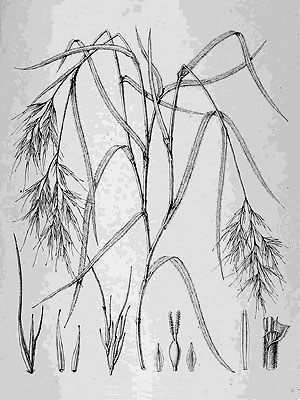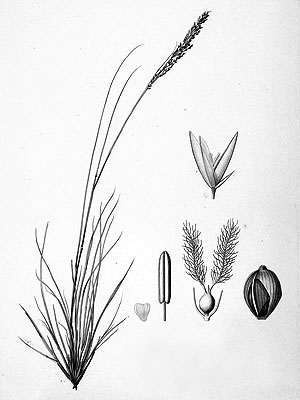Tulcan Feather Grass (Stipa tulcanensis)
The Tulcan Feather Grass is only known from type material collected in the late 1870s somewhere in the Carchi Province, in the Andes of Ecuador.
***
The species’ scientific name is considered ‘unplaced’, meaning further research is needed to clarify the exact status of the plant.
*********************
edited: 30.01.2012
Tag Archives: Poaceae
Podophorus bromoides Phil.
Brome-like Podophorus Grass (Podophorus bromoides)
The Brome-like Podophorus Grass was described in 1856; it obviously was restricted to the Isla Robinson Crusoe in the Juan Fernandez Islands, Chile; even at that time only a single plant was found.:
“Of this curious grass we have seen only one specimen, sent to Kew by Philippi himself in 1861.” [1]
The species was never found again since, as already the Swedish botanist Carl Skottsberg states in 1921.:
“Discovered by Germain in the latter half of October, 1854. Philippi states … that it is >>frequens in insula Juan Fernandez>>, but it has never been found a second time. All the material consists of the two sheets in Santiago and a third one in Kew. I need not tell that we made a careful search after this most interesting grass, but unfortunately without result. I must believe that this is a very rare plant.” [2]
The species is now considered extinct.
*********************
References:
[1] C. Wyville Thamson; John Murray: Report on the scientific results of the Voyage of H. M. S. Challenger during the years 1873-76. Narrative – Vol. I. first part. 1. 1885
[2] Carl Skottsberg: The Natural History of Juan Fernandez and Easter Island. Uppsala, Almqvist & Wiksells Boktryckeri 1920-1956
*********************

Depiction from: ‘C. Wyville Thamson; John Murray: Report on the scientific results of the Voyage of H. M. S. Challenger during the years 1873-76. Narrative – Vol. I. first part. 1. 1885′
(public domain)
*********************
edited: 16.05.2022
Sartidia perrieri (A. Camus) Bourreil
Perrier’s Sartidia Grass (Sartidia perrieri)
This grass species is known exclusively from the type material that was found in 1914 growing on sandstone rocks in a woodland near Antsirabe at an elevation of about 1900 m; it appears to have already been very rare at that time.
The species was never recorded again and is now considered most likely extinct.
***
syn. Aristida perrieri A. Camus
*********************
References:
[1] Maria S. Vorontsova; Thomas Haevermans; Agathe Haevermans; Jacqueline Razanatsoa; Marjorie R. Lundgren; Guillaume Besnard: The Genus Sartidia (Poaceae: Aristidoideae) in Madagascar. Systematic Botany 40(2): 1-6. 2015
*********************
edited: 08.01.2024
Arundinella kerrii Teerawat. & Sungkaew
Kerr’s Arundinella Grass was described in 2011; it is known only from material that was collected in 1924 in the Nakhon Phanom Province of northeastern Thailand, where it was found growing in open grassland at elevations of about 200 m.
The species was not found since despite attempts to recollect it at its type locality. [1]
*********************
References:
[1] Atchara Teerawatananon; Sarawood Sungkaew; Trevor R. Hodkinson: Arundinella kerrii and Dimeria kerrii, Two New Endemic Species from Thailand (Poaceae, Panicoideae). Novon 21(1): 149-153. 2011
*********************
edited: 16.05.2022
Eragrostis rottleri Stapf
Rottler’s Lovegrass (Eragrostis rottleri)
Rottler’s Lovegrass is known exclusively by the type material which was collected already in 1779 somewhere in the vicinity of the city of Tharangambadi (formerly Tranquebar) at the eastern coast of Tamil Nadu, India.
This species is certainly extinct.
*********************
edited: 20.08.2022
Amphibromus whitei C. E. Hubb.
White’s Wallaby Grass (Amphibromus whitei)
White’s Wallaby Grass is only known from the type material, that was collected in the year 1933 at the edge of a large fresh water swamp in an area named Maranoa in the south of Queensland.
It is an about 20 to 35 cm tall grass.
The species was never fund again, and is considered most likely extinct.
*********************
edited: 23.09.2017
Eragrostis mauiensis Hitchc.
Maui Lovegrass (Eragrostis mauiensis)
The Maui Lovegrass was described in 1922, the species is apparently known only from the type that was collected on sandhills at Wailuku on the eastern part of Maui, Hawaiian Islands.
The species may also have occurred on the island of Lana’i. [1]
*********************
References:
[1] A. S. Hitchcock: The grasses of Hawaii. Memoirs of the Bernice Pauahi Bishop Museum 8(3): 1-132. 1922
*********************

(public domain)
*********************
edited: 05.04.2018
Deyeuxia lawrencei Vickery
Lawrence’s Bentgrass (Deyeuxia lawrencei)
Lawrence’s Bentgrass was described in 1940, it is known only from the type specimen that was collected around 1831 probably somewhere near the city of Launceston in the northern part of Tasmania, Australia.
The species was never recorded again since and is thougth to be extinct. [1]
*********************
References:
[1] Mark Wapstra; Fred Duncan; Alex Buchanan; Richard Schahinger: Finding a botanical Lazarus: Tales of Tasmanian plant species ‘risen from the dead’. The Tasmanian Naturalist 128: 61-85. 2006
*********************
edited: 08.01.2019
Paspalum batianoffii B. K. Simon
Batianoff’s Paspalum Grass (Paspalum batianoffii)
Batianoff’s Paspalum Grass was described in 1992, it was collected in the Statue Bay, about 6,5 km southeast of the town of Yeppon in the Gladstone District (formerly Port Curtis District) in Queensland, Australia.
The species had 20 to 40 cm long, creeping stems.
Batianoff’s Paspalum Grass inhabited a very narrow foredune with open wood land consisting of some common, widely distributed plant species, it was found growing directly above the flood mark, acting as a sand stabilizer.
***
The species is apparently extinct today, however, the reasons for this appear to be unknown.
*********************
edited: 19.06.2020
Festuca archeri E. B. Alexeev
Archer’s Fescue (Festuca archeri)
Archer’s Fescue, described in 1987, is known only from the type material that was collected at an unknown locality and that consists only of the upper part of a single culm and its inflorescence.
The species is very doubtful and may in fact not even be valid. [1]
*********************
References:
[1] Mark Wapstra; Fred Duncan; Alex Buchanan; Richard Schahinger: Finding a botanical Lazarus: Tales of Tasmanian plant species ‘risen from the dead’. The Tasmanian Naturalist 128: 61-85. 2006
*********************
edited: 15.01.2024
Paspalum amphicarpum Ekman
Amphicarpic Paspalum Grass (Paspalum amphicarpum)
The Amphicarpic Paspalum Grass was described in 1942, it appears to be endemic to the western regions of Cuba: the type was collected in 1923 at the edge of a pool near Laguna de Piedras in the Province of Pinar del Río [it might actually also occur in South America, I wasn’t able to find out yet].
This is a glabrous, widely creeping aquatic or subaquatic perennial with ascending branches, it is furthermore known to produce subterranean spikes with cleistogame (self-pollinating) flowers as well as normal aerial inflorescences. [1][2]
***
The species’ name appears in lists of extinct species, so is extinct at least on the island of Cuba to which it might have been endemic.
*********************
References:
[1] Agnes Chase: The North American species of Paspalum. Contributions from the United States National Herbarium 28(1): 1-317. 1942
[2] H. E. Connor: Breeding systems in the grasses: a survey. New Zealand Journal of Botany 17: 547-574. 1979
*********************

(under creative commons license (3.0))
http://creativecommons.org/licenses/by-nc-sa/3.0
*********************
edited: 19.06.2020
Sporobolus durus Brongn.
Ascension Island Dropseed Grass (Sporobolus durus)
The Ascension Island Dropseed Grass is one of the few native resp. endemic plant species of Ascension Island.
The species was last recorded in the year 1886 at the White Horse Hill, where it grew at an elevation of about 450 m. This place is now densely covered with the introduced Molasses Grass (Melinis minutiflora P. Beauv.).
The Ascension Island Dropseed Grass could not be relocated during extensive searches in the year 1998, and it is now considered extinct.
*********************

(public domain)
*********************
edited: 18.05.2011
